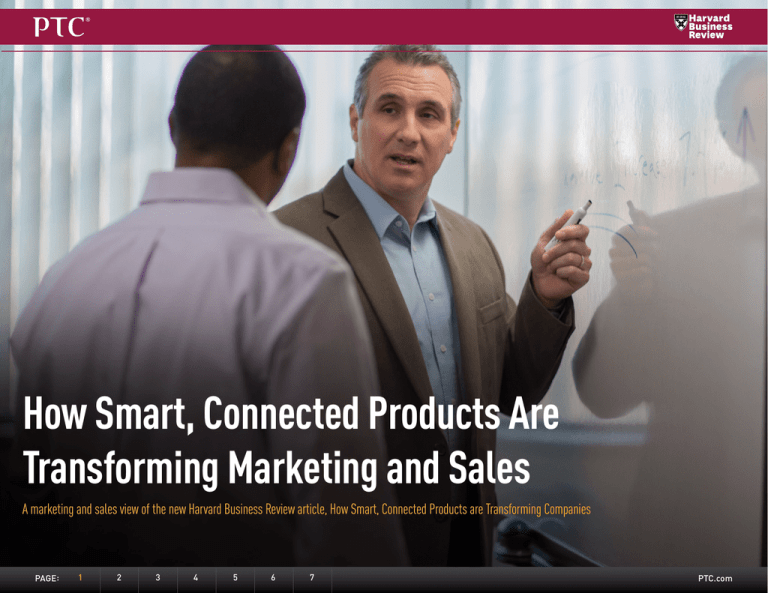
How Smart, Connected Products Are
Transforming Marketing and Sales
A marketing and sales view of the new Harvard Business Review article, How Smart, Connected Products are Transforming Companies
PAGE:
1234 567
PTC.com
THE DEFINITIVE ARTICLES ON THE IoT
PTC President and CEO, Jim Heppelmann, and Professor Michael Porter of
the Harvard Business School, collaborated on a multi-year research project
to understand the impact of smart, connected products, commonly referred to
as the “Internet of Things,” on competition and companies.
HBR.ORG
NOVEMBER 2014
REPRINT R1411C
Smart, connected products
will give rise to the next era of
IT-driven productivity growth at
a time when the impact of earlier
waves of IT has largely played
itself out.”
– November 2014
SPOTLIGHT ON MANAGING THE INTERNET OF THINGS
How Smart,
Connected Products
Are Transforming
Competition
The findings of their research were published in two Harvard Business Review
articles, How Smart, Connected Products Are Transforming Competition
published in the November 2014 issue, and How Smart, Connected Products
Are Transforming Companies published in the October 2015 issue.
by Michael E. Porter and James E. Heppelmann
HBR.ORG
Michael Porter
Harvard Business School
Jim Heppelmann
President and CEO, PTC
How Smart,
Connected Products
Are Transforming
Companies
The operations and organizational structure of firms are being radically
reshaped by products’ evolution into intelligent, connected devices.
by Michael E. Porter and James E. Heppelmann
R1510Gf2.indd 1
PAGE:1
2 34 56 7
OCTOBER 2015
REPRINT R1510G
9/22/15 3:44 PM
Smart, connected products are
transforming how companies
design, manufacture, operate and
service products, and ultimately,
how they organize to create and
capture value.”
– October 2015
PTC.com
TRANSFORMING COMPANIES: EXECUTIVE SUMMARY
How Smart, Connected Products are Transforming Companies, the second in
this two-part series, focuses on the impact of smart, connected products on
companies’ operations and organizational structure.
The unprecedented data and capabilities that smart, connected products
generate are driving this transformation. The impact is reshaping the work of
virtually every function in the Value Chain, including product development, IT,
manufacturing, logistics, marketing, sales, and after-sale service.
In addition, new forms of cross-functional collaboration and entirely new
functions are emerging:
• IT & R&D Collaboration: Reflecting the new need for IT in
product development
• Unified Data Organization: Handles enterprise-wide data management
and analytics
• Dev-Ops: Oversees ongoing product updates and efforts to shorten
product-release cycles
• Customer Success Management: Ensures customers gain ongoing value
to reduce churn
How will marketing and sales need to transform in order to capitalize on the
unprecedented data and capabilities that smart, connected products generate?
PAGE:1
2
34 56 7
PTC.com
TRANSFORMING THE VALUE CHAIN
The Value Chain, a concept defined by Michael Porter in his 1985 best-seller Competitive Advantage, are the many discrete activities a firm performs in designing, producing, marketing, delivering and supporting its product. Each of these activities contributes to a firm’s cost and creates a basis for differentiation, which
enables competitive advantage. Using Porter’s Value Chain framework, the impact of smart, connected products on each activity is analyzed.
The “Marketing & Sales” activities include the product pricing, packaging, promotion, and selling. The activities are performed to inform buyers about products
and services, induce buyers to purchase them, and facilitate their purchase.
Firm Infrastructure
Human Resource Management
Technology Development
Procurement
Inbound
Logistics
Operations
Oubound
Logistics
1234 56 7
PAGE:
Margin
MARKETING
& SALES
After-Sales
Service
PTC.com
TRANSFORMING MARKETING AND SALES
The ability to remain connected to the product and track how it’s being used shifts the focus of a company’s customer relationship from selling—often a predominantly one-time transaction—to maximizing the customer’s value from the product over time. This opens up important new requirements and opportunities for
marketing and sales.
These new marketing and sales principles are becoming foundational for competing in a smart, connected world:
:
NEW WAYS TO SEGMENT AND CUSTOMIZE: Product data provide new insights, for example, which features customers prefer or fail to
use, which enable organizations to tailor special offers and develop more-sophisticated product packaging and pricing strategies.
NEW CUSTOMER RELATIONSHIPS: As companies remain connected to their customers via the product, the product becomes a means
of delivering ongoing value and as a sensor into the needs and satisfaction of customers, rather than the end itself.
NEW BUSINESS MODELS: Expanding the number of services and selling products as-a-service has major implications for sales and
marketing. The goal becomes customer success and renewals, instead of product sales.
A FOCUS ON SYSTEMS, NOT DISCRETE PRODUCTS: As products become components of larger systems, the customer value proposition
broadens. Companies must decide where to play in this new world, and position their offerings within the larger systems.
1234 56 7
PAGE:
PTC.com
INDUSTRY ANALYST PERSPECTIVE
Voice of the Product: Smart Connected Products Transform Marketing
— By Kathleen Schaub, Vice President, IDC CMO Advisory Service
Smart, connected, products (SCPs) open the door to a new dynamic between
manufacturers and their customers. Space and time barriers fall away.
Products gain new ears and new voices that invite relationships that are
richer, more intimate, and more advantageous to both parties. To activate
this value, marketing executives must not only boost 21st century marketing
skills, they must rethink their marketing strategy in totally new ways.
The voice of smart, connected, products provides marketers with masses
of real-time data describing actual usage. Behavioral analysis based on
this data is an exceptional tool for understanding customers and creating
meaningful segments. Human behavior is very complex. Marketers used
to be stuck with inadequate strategies for segmentation — methods such
as gut-feelings, past experience, and traditional rule-based methods like
parsing by vertical markets. Without behavioral data, marketers will miss
important insights (at best), or will be biased and wrong (at worst).
In the recent Harvard Business Review article How Smart, Connected
Products are Transforming Companies, authors James E. Heppelmann and
Michael E. Porter describe the powerful insights gained by combining data
from SCPs with data from other sources. Supplemental sources include
operational systems (e.g., CRM, customer service, logistics, and finance) and
customer interaction systems (e.g., click streams, search, and geographic
data, downloads, or video views). Data can also be also accessed from third
parties (e.g., list companies, media, or from databases such as SEC filings).
By integrating data from SCPs with other data, marketers will be able to…
Read the full article on PTC.com
1234 567
PAGE:
PTC.com
SUMMARY
The capabilities and data generated by smart, connected products dramatically increase the opportunities for value creation and higher productivity,
but require companies to build and support a new technology stack and face
10 new strategic choices.
This innovation is going to transform the nature of work across all business
functions, which require new skills such as software development,
data science, UI design, IoT security, and systems integration, that are
in short supply.
We are still early in the transformation and the organizational transition will be
evolutionary, with old and new structures operating in parallel for many years.
To get started however, it is critical for companies to align on these concepts
across business functions and define a comprehensive strategy. Defining and
prioritizing IoT use cases, like New Billing and Pricing Models, to pilot is the
clearest path to creating value. If you’re ready to go from thinking about IoT to
winning in the new competitive environment of smart, connected products,
request an Innovation Workshop.
© 2015, PTC Inc. All rights reserved. Information described herein is furnished for informational use only, is subject to change without notice, and should not be taken as a guarantee, commitment,
condition or offer by PTC. PTC, the PTC logo, Product & Service Advantage, Creo, Elements/Direct, Windchill, Mathcad, Arbortext, PTC Integrity, Servigistics, ThingWorx, ProductCloud and all other
PTC product names and logos are trademarks or registered trademarks of PTC and/or its subsidiaries in the United States and other countries. All other product or company names are property of
their respective owners.
J6339–How Smart, Connected Products Are Transforming Marketing and Sales –EN–1115
1 2 34 56 7
PAGE:
PTC.com

